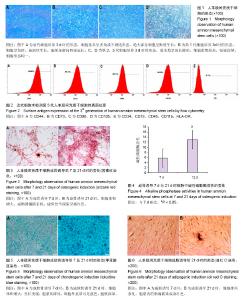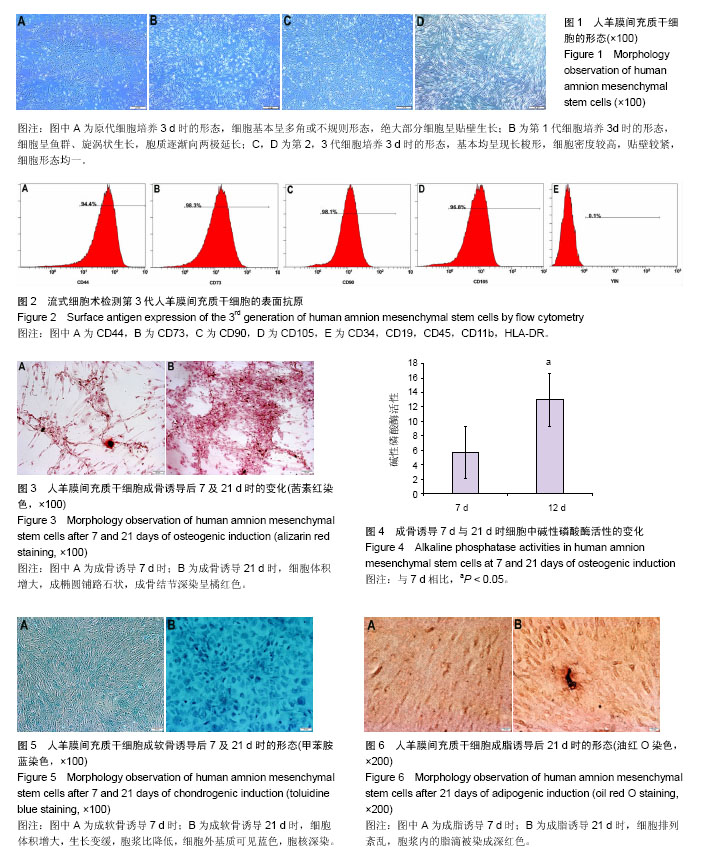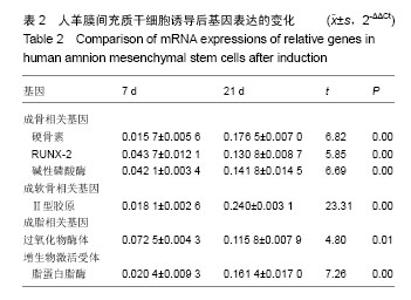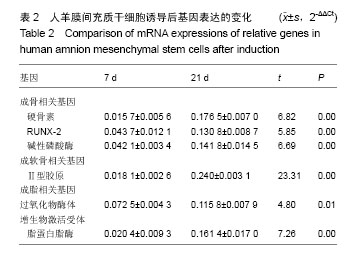| [1] Fayyad-Kazan M, Fayyad-Kazan H, Lagneaux L, et al. The potential of mesenchymal stromal cells in immunotherapy. Immunotherapy. 2016;8(8):839-842. [2] Kim SH, Bang SH, Kang SY, et al. Human amniotic membrane-derived stromal cells (hAMSC) interact depending on breast cancer cell type through secreted molecules. Tissue Cell. 2015;47(1):10-16. [3] Cortes Y, Ojeda M, Araya D, et al. Isolation and multilineage differentiation of bone marrow mesenchymal stem cells from abattoir-derived bovine fetuses. BMC Vet Res. 2013;9:133. [4] Vargas D, Rosales W, Lizcano F. Modifications of Human Subcutaneous ADMSC after PPARγ Activation and Cold Exposition. Stem Cells Int. 2015;2015:196348. [5] Fu Q, Tang NN, Zhang Q, et al. Preclinical Study of Cell Therapy for Osteonecrosis of the Femoral Head with Allogenic Peripheral Blood-Derived Mesenchymal Stem Cells. Yonsei Med J. 2016;57(4):1006-1015. [6] 金瑛,李豫皖,张承昊,等.体外诱导人羊膜间充质干细胞向韧带细胞分化的实验研究[J].中国修复重建外科杂志,2016(2):237-244.[7] ilioli Uranio M, Dell'Aquila ME, Caira M, et al. Characterization and in vitro differentiation potency of early-passage canine amnion- and umbilical cord-derived mesenchymal stem cells as related to gestational age. Mol Reprod Dev. 2014;81(6): 539-551. [8] Maidhof R, Rafiuddin A, Chowdhury F, et al. Timing of mesenchymal stem cell delivery impacts the fate and therapeutic potential in intervertebral disc repair. J Orthop Res. 2016. in press.[9] Nogami M, Kimura T, Seki S, et al. A Human Amnion-Derived Extracellular Matrix-Coated Cell-Free Scaffold for Cartilage Repair: In Vitro and In Vivo Studies. Tissue Eng Part A. 2016; 22(7-8):680-688.[10] 洪佳琼,高雅,宋洁,等.人羊膜间充质干细胞与骨髓间充质干细胞的生物学特性及免疫抑制作用的比较[J].中国实验血液学杂志, 2016,24(3):858-864.[11] 方宁,张路,宋秀军,等.人羊膜间充质干细胞的分离、培养及鉴定[J].遵义医学院学报,2009,32(3):234-236.[12] Bilic G, Zeisberger SM, Mallik AS, et al. Comparative characterization of cultured human term amnion epithelial and mesenchymal stromal cells for application in cell therapy. Cell Transplant. 2008;17(8):955-968.[13] Kim EY, Lee KB, Kim MK. The potential of mesenchymal stem cells derived from amniotic membrane and amniotic fluid for neuronal regenerative therapy. BMB Rep. 2014;47(3): 135-140.[14] Kadam SS, Sudhakar M, Nair PD, et al. Reversal of experimental diabetes in mice by transplantation of neo-islets generated from human amnion-derived mesenchymal stromal cells using immuno-isolatory macrocapsules. Cytotherapy. 2010;12(8):982-991. [15] Lee PH, Tu CT, Hsiao CC, et al. Antifibrotic Activity of Human Placental Amnion Membrane-Derived CD34+ Mesenchymal Stem/Progenitor Cell Transplantation in Mice With Thioacetamide-Induced Liver Injury. Stem Cells Transl Med. 2016. in press.[16] Crane JL, Xian L, Cao X. Role of TGF-β Signaling in Coupling Bone Remodeling. Methods Mol Biol. 2016;1344:287-300. [17] Song K, Huang M, Shi Q, et al. Cultivation and identification of rat bone marrow-derived mesenchymal stem cells. Mol Med Rep. 2014;10(2):755-760. [18] Cui Y, Yao M, Liu Y, et al. Effects of cartilage-derived morphogenetic protein 1 (CDMP1) transgenic mesenchymal stem cell sheets in repairing rabbit cartilage defects. Genet Mol Res. 2016;15(2). [19] Xi Q, Wang Z, Zaromytidou AI, et al. A poised chromatin platform for TGF-β access to master regulators. Cell. 2011; 147(7):1511-1524. [20] Mueller MB, Blunk T, Appel B, et al. Insulin is essential for in vitro chondrogenesis of mesenchymal progenitor cells and influences chondrogenesis in a dose-dependent manner. Int Orthop. 2013;37(1):153-158. [21] Zhuang H, Zhang X, Zhu C, et al. Molecular Mechanisms of PPAR-γ Governing MSC Osteogenic and Adipogenic Differentiation. Curr Stem Cell Res Ther. 2016;11(3):255-264.[22] Contador D, Ezquer F, Espinosa M, et al. Dexamethasone and rosiglitazone are sufficient and necessary for producing functional adipocytes from mesenchymal stem cells. Exp Biol Med (Maywood). 2015;240(9):1235-1246. [23] Song WW, McLennan SV, Tam C, et al. CCN2 requires TGF-β signalling to regulate CCAAT/enhancer binding proteins and inhibit fat cell differentiation. J Cell Commun Signal. 2015;9(1): 27-36. |



